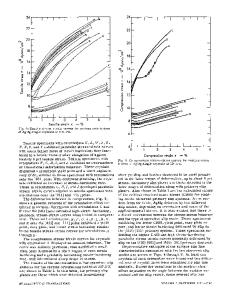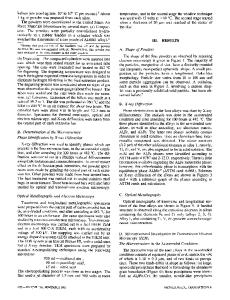Rapidly Solidified Long Range Ordered Alloys
- PDF / 1,536,735 Bytes
- 5 Pages / 417.6 x 639 pts Page_size
- 4 Downloads / 407 Views
1982
by Elsevier
Science
Publishing
Co.,
Inc.
RAPIDLY SOLIDIFIED AMORPHOUS ANDCRYSTALLINE ALLOYS B.H.
Kear,
B.C.
Giessen,
and
M.
Cohen,
375
editors
RAPIDLY SOLIDIFIED LONG RANGE ORDERED ALLOYS*
E.
H. LEE,
C. C. KOCH,
AND C. T. LIU
Metals and Ceramics Division, Oak Ridge National Laboratory, P.O. Ridge, Tennessee, 37830
Box X, Oak
ABSTRACT The influence of rapid solidification processing on the
microstructure of long-range-ordered alloys in the (Fe,Co, Ni) 3 V system has been studied by transmission electron microscopy. The main microstructural feature of the asquenched alloys was a fine cell structure (-300 nm diameter)
decorated with carbide particles. This structure was maintained after annealing treatments which develop the ordered crystal structure. Other features of the microstructures both before and after annealing are presented and discussed. I.
INTRODUCTION
Intermetallic compounds or intermediate phases in metallic systems which possess long range chemical order have several potential advantages over disordered alloys for elevated temperature applications. The restricted atomic mobility that the ordered lattice provides can result in better resistance to thermally activated deformation, e.g. creep. Strengthening can rely on the inherent ordered structure so stability of second phase precipitates becomes
less important. A severe drawback on utilization of long-range ordered (LRO) alloys has been low ductility; especially at ambient temperature. Recently this problem has been solved in (Fe,Co,Ni) 3 V base LRO alloys by stabilizing a ductile LRO fcc phase by alloy chemistry modification [1]. LRO alloys in this system can have ductilities at room temperature of >30% tensile elongation. The potential application of the fcc (Fe,Co,Ni) 3 V base LRO alloys has led to consideration of scale-up from laboratory heats. This requires use of less pure components and the inevitable development of impurity inclusions - notably VC. Rapid solidification processing (RSP) techniques have been used recently to homogenize and refine the microstructure of superalloys [2] and 316 stainless steel [3]. In this work we have applied RSP to several (Fe,Co,Ni) 3 V LRO alloys in order to evaluate the resulting microstructure and the efficacy of RSP for improving properties of these alloys. II.
EXPERIMENTAL
Compositions of the alloys used in this investigation are given in Table I. The alloys used in the rapid solidification study had been prepared by conventional methods of arc-casting, solution annealing, and hot fabrication. Small pieces (-50-60 mg) were cut from the alloy plates for rapid solidification. Rapid solidification was accomplished in an arc-hammer apparatus which has been described previously [4]. The quenching rate is estimated to be at least 106 K/s [4]. As-quenched samples were typically disks approximately 1.5-2 cm diameter and 30 Vm thick. Selected samples were given annealing treatments which are *Research sponsored by the Division of Materials Sciences,
U.S. Department
of Energy under
Data Loading...











